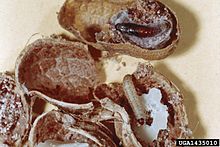Cadra
Appearance
| Cadra | |
|---|---|

| |
| Almond moth (C. cautella), caterpillar (below) and pupa (above) in peanut husks | |
| Scientific classification | |
| Domain: | Eukaryota |
| Kingdom: | Animalia |
| Phylum: | Arthropoda |
| Class: | Insecta |
| Order: | Lepidoptera |
| Family: | Pyralidae |
| Tribe: | Phycitini |
| Genus: | Cadra Walker, 1864 |
| Species | |
|
Several, see text | |
| Synonyms | |
| |
Cadra is a
entomological sources. Cadra and Ephestia belong to the huge snout moth subfamily Phycitinae, and therein to the tribe Phycitini
.
Cadra species can usually be recognized by their reduced forewing venation: veins 4, 7 and 9 are missing, making for a total of nine veins in the forewing. Some members of this genus are significant pests of dry plant produce, such as seeds and nuts. The almond moth (C. cautella) is a well-known example of these.[1]
Species
- Cadra abstersella (Zeller, 1847)
- Cadra acuta Horak, 1994
- Cadra calidella (Guenée, 1845) – dried fruit moth, carob moth
- Cadra cautella– almond moth
- Cadra corniculata Horak, 1994
- Cadra delattinella Roesler, 1965
- Cadra figulilella – raisin moth
- Herrich-Schäffer, 1849)
- Cadra furcatella afflatella
- Cadra furcatella calonella
- Cadra perfasciata Horak, 1994
- Cadra reniformis Horak, 1994
- Cadra rugosa Horak, 1994
Footnotes
- ^ Clarke (1986)
- ^ "GlobIZ search". Global Information System on Pyraloidea. Retrieved June 21, 2017.
References
- Clarke, John Frederick Gates (1986): Pyralidae and Microlepidoptera of the Marquesas Archipelago. Smithsonian Contributions to Zoology 416: 1–485. PDF full text Archived 2012-03-27 at the Wayback Machine (214 MB!)
- Savela, Markku (2009): Markku Savela's Lepidoptera and Some Other Life Forms – Cadra. Version of 14 April 2009. Retrieved 10 April 2010.
